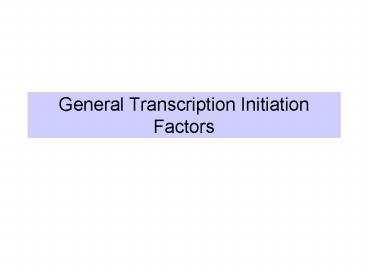General Transcription Initiation Factors - PowerPoint PPT Presentation
1 / 23
Title:
General Transcription Initiation Factors
Description:
TATA ... TATA. Inr. Polymerization of 1st few NTPs and phosphorylation of CTD leads to ... It does NOT always bind to TATA boxes; promoters for RNA Pol I ... – PowerPoint PPT presentation
Number of Views:306
Avg rating:3.0/5.0
Title: General Transcription Initiation Factors
1
General Transcription Initiation Factors
2
Accurate initiation by bacterial RNA polymerase
E. coli RNA pol holoenzyme
Promoter
initiation
Nascent RNA
elongation
RNA Pol core
Run-off transcript, Discrete size
3
Random transcription by bacterial RNA polymerase
core
E. coli RNA pol core
Promoter
Random initiation
elongation
Transcripts of random size
4
Random transcription by eukaryotic RNA polymerase
Eukaryotic RNA pol II
Promoter
Random initiation
elongation
Transcripts of random size
5
Accurate initiation by Euk RNA polymerase II
plusfactors in the nucleus
Eukaryotic RNA pol II
Nuclear extract, S-100
Promoter
General Transcription Initiation Factors
initiation
Nascent RNA
elongation
Run-off transcript, Discrete size
6
General transcription factors GTFs
- Proteins other than RNA polymerase involved in
transcription - Initiation, Elongation, Termination
- General transcription initiation factors (GTIFs)
- Proteins required for specific transcription from
a minimal promoter (core) - Not subunits of purified RNA polymerase.
- Required for RNA polymerase to bind avidly and
specifically to promoters. - GTIFs for RNA polymerase II are called TFIIx,
where x A, B, D, - Can have multiple subunits
7
Fractionation of nuclear extracts to find
GTFsPhosphocellulose column ion exchange
Plus Purified Pol II
Run-off Transcript Accurate Initiation at
promoter
Template Adenovirus late promoter
8
Fractionation of nuclear extracts to find
GTFsFractionation scheme, DEAE cellulose
Plus Purified Pol II
Run-off Transcript Accurate Initiation at
promoter
Matsui, Segall, Weil, Roeder (1980) JBC 25511992
9
GTIFs for RNA polymerase II
Modulates helicase
Helicase
helicase
IIF
IIH
Targets Pol II to promoter
Recognize core promoter
CTD protein kinase
protein kinase
IIF
IIH
CTD of large subunit of Pol II
Many GTIFs are possible targets for activators of
transcription.
10
TATA Binding Protein TBP
- TBP binds in the narrow groove of DNA at the TATA
box found about 20-25 bp 5 to the start site for
transcription of many (but not all) genes
transcribed by RNA polymerase II. - TBP bends the DNA about 90 degrees.
- TBP alone or with TBP-associated proteins (TAFs)
plays an important role in recognizing the core
promoter and recruiting RNA polymerase II to the
promoter.
11
TBP bound to DNA
Image from crystal structures, provided by Dr. T.
Nixon.
12
RNA Pol II bound to DNA and general transcription
initiation factors
13
Movie of TBP, then binding to TATA DNA (and
bending it), and then TFIIA binding to TBP-TATA
- Thanks to Drs. Song Tan and Tracy Nixon for movies
14
Sequential Binding Model for assembly of
preinitiation complex
PIC
Polymerization of 1st few NTPs and
phosphorylation of CTD leads to promoter
clearance. TFIIB, TFIIE and TFIIH dissociate,
PolIIIIF elongates, and TFIID TFIIA stays at
TATA.
Activated PIC
15
Direct Binding of Holoenzyme model for assembly
of the preinitiation complex
PIC
Activated PIC
16
Other proteins involved in transcription and
regulation
- In addition to RNA polymerase II and GTFs
- Proteins required for regulation, e.g.
- Gal11 regulation of the GAL operon
- Rgr1 resistance to glucose repression
- Srb proteins
- Yeast strains with truncations in the CTD of the
large subunit of RNA polymerase B are
cold-sensitive - SRB genes when mutated, suppress the phenotype
of CTD deletions - Extragenic suppressors implicated in RNA
polymerase function
17
RNA polymerase II Holoenzyme and Mediator
- Holoenzyme
- RNA polymerase II (TFIIB, E, F, H ) (Srb2, 4,
5, 6) (Rgr1, Gal11, others) - Correct initiation in presence of TBP (TFIID)
- Responds to transcriptional activators
- Mediator
- Complex needed for a response to transcriptional
activators by purified RNA Pol II plus GTFs - Yeast Mediator has 20 subunits, including Srb2,
4, 5, 6 Srb7, Rgr1, Gal11, Med 1, 2, 6, 7, Pgd1,
Nut 1, 2, and others - RNA Pol II Mediator ( some GTFs?) Holoenzyme
18
Expanding the functions of RNA polymerase
19
Stages in Initiation of Transcription
- Bacterial transcription
- Closed complex holoenzymepromoter
- Open complex (DNA melting, not need ATP)
- Abortive transcripton
- Productive initiation
- Transcribe past 9
- Sigma dissociates
- Elongation
- Eukaryotic transcription
- Preinitiation complex (PIC) assembly
- PIC activation (DNA melting, needs ATP)
- Abortive transcription
- Productive initiation
- CTD phosphorylated
- Promoter clearance
- Elongation
20
Parallels between initiation pathway in
prokaryotes and eukaryotes
From Eick et al. (1994) Trends in Genetics 10
292-296
21
GTFs for RNA polymerase I
22
GTFs for RNA polymerase III
23
TBP is used by all 3 RNA polymerases
- TBP is a subunit of an important GTF for each of
the 3 RNA polymerases - TBP or TFIID for Pol II
- SL1 for Pol I
- TFIIIB for Pol III
- It does NOT always bind to TATA boxes promoters
for RNA Pol I and Pol III (and even some for Pol
II) do not have TATA boxes, but TBP is still
used. - The GTFs that contain TBP may serve as
positioning factors for their respective
polymerases.































